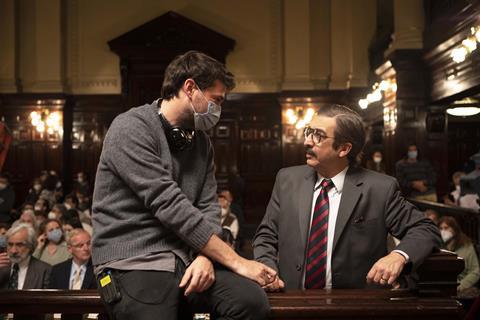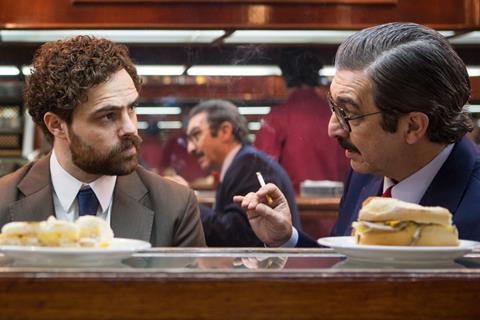The prosecution of Argentina’s military junta was a landmark event but barely shown on television. Director Santiago Mitre tells Screen how his Oscar- and Bafta-nominated film brings the trial to life and why it resonates in today’s age of democratic deficit.

The revolution was never fully televised in Argentina. Only a few minutes of the historic 1985 trial of the South American country’s former military leaders — the subject of Argentina, 1985 — were allowed into people’s living rooms. The film’s director was an infant at the time but as he came of age, Santiago Mitre knew it was a story deserving of a wider audience.
“I don’t have real memories about the trial, just vague memories of the happiness in my house when democracy came back,” says Mitre, who is talking from Argentina’s Cordoba wine region in late January, days after the Amazon Studios drama earned his country’s first best international feature film Oscar nomination since Wild Tales in 2014, to add to its Golden Globe for best non-English-language picture.
“It was a brave and risky decision the government took [to prosecute the generals] and it was super important in helping rebuild Argentina after the atrocities of the dictatorship,” says the filmmaker, whose credits include 2015 Cannes Critics’ Week grand prize winner Paulina and 2017 political thriller The Summit.
Mitre was four at the time of the so-called Trial of the Juntas, a reference to the murderous military leaders who ruled the country with an iron fist from 1976-83, resulting in the disappearance of an estimated 30,000 people.
Growing up in a fiercely political family in the latter part of the 1980s and 1990s, the events of Argentina’s Dirty War and the subsequent trial took on a deep personal significance for Mitre. His parents had protested during the regime and politics was a common discourse at the dining table and family gatherings.
“My mother works in the justice department and my father works in international politics,” he says. “My grandfather was ambassador [to Haiti and the United Nations], and my great-grandfather was the agriculture minister. So the family was kind of related to politics.”
The fascination for events surrounding the trial would not go away, and it would only be after Mitre had established himself as a filmmaker that he felt ready to tackle his first feature based on actual events.
Mitre attended film school in his native Buenos Aires in the early 2000s and co-directed his first feature, romantic comedy Love (Part One), in 2004. Then he struck up a collaboration with Pablo Trapero, co-writing the filmmaker’s 2008 Cannes entry Lion’s Den. Trapero’s star was rising, and the film was a critical success, winning best Ibero-American film at Mexico’s Ariel Awards in 2009. Mitre further collaborated with his fellow Argentine on Carancho and White Elephant, and also wrote with Walter Salles and Damian Szifron.
In 2011, Mitre directed his first solo feature The Student, which was set against the backdrop of university politics, winning best first work from the Argentinian Academy and the special jury prize at Locarno. Four years later, his second feature Paulina — the story of an idealistic schoolteacher (played by Mitre’s wife Dolores Fonzi) — premiered at Cannes, winning the Fipresci award and the Critics’ Week grand prix.
It was while finishing geopolitical drama The Summit, starring Ricardo Darin, that Mitre began researching the 1985 trial. He recalled his mother telling him about lead prosecutor Julio César Strassera, whom she had met while working in the justice department library — “this weird personality, funny and super nice, but also grumpy — a special character”.
Redemption tale

Mitre knew he had found his way into the story. Like many who held public office during Argentina’s Dirty War, Strassera wished he had done more to support democracy during the regime. As he took on the case, the lawyer, working with colleague Luis Moreno Ocampo (played in the film by Peter Lanzani) and a cadre of young legal eagles, knew this could be his second chance.
“That was my turning point in the research,” recalls Mitre. “I wanted to show that changes are possible if you commit yourself with passion and use the energy of the young generation.” He told Darin about the project and the actor — feted for a rich career including roles in Oscar-winning film The Secret In Their Eyes and Wild Tales — immediately committed as star and producer. Darin’s Kenya Films would produce Argentina, 1985 alongside Mitre’s La Unión De Los Rios and UK, Los Angeles and Buenos Aires-based Infinity Hill.
After several years of research and writing the screenplay — in which time Mitre had shot French comedy 15 Ways To Kill Your Neighbour (Petite Fleur) a couple of months prior to the pandemic — filming began on Argentina, 1985. They shot from July to September 2021 in Buenos Aires and other parts of the country, gaining access to the Palace of Justice where the trial took place.
Working closely with cinematographer Javier Julia, Mitre shot the courtroom scenes with a U-matic camera like the one used to film the trial itself, and interspersed that with shots from a Alexa LF and original trial footage. Mitre and co-writer Mariano Llinas had pored over archival recordings of the trial and the testimony of survivors who had been kidnapped, raped and terrorised by the junta. They interviewed politicians, journalists who covered the trial, and the witnesses themselves.
The entire trial was filmed and open to the public, but Mitre says only five minutes made it onto the TV news at the time and none of the witnesses’ faces was shown. The regime may have collapsed two years prior, but its architects and conspirators, including the police, still walked free. It was a dangerous time. Mitre and Julia were keen to show the actors’ faces. “We needed to show their anger and pain testifying for the first time.”
Every word spoken by the actors in the trial scenes is based on court transcripts, including Strassera’s climactic summation. While Mitre did not want the cast to mimic the original speeches and testimonies, he wanted to be “respectful with the truth of the people who sat there and testified”.
Although production took place during Covid when cinemas in Argentina were closed, Mitre had the backing of Amazon and knew the film would get seen via Prime Video. It did, but there was some good luck involved, too. By the time Argentina, 1985 premiered in Competition at Venice in late summer 2022, the pandemic had receded and the film saw a theatrical release in Argentina on September 30 through DigiCine.
Amazon Prime is not sharing numbers but the film was embraced by audiences, earning close to $1m. “It was amazing,” recalls Mitre. “They were clapping in the middle of the scenes and there was a lot of crying. Our society needed this trial… people wanted to see this collective achievement of Argentina surrounded by other people.”
The film sparked conversations up and down the country — and its broader international relevance continues to resonate. “We wanted to speak to contemporary society,” says Mitre. “We are seeing speeches that seem to not respect democracy. We see what happened in Brazil not long ago, what happened to the US not long ago, all the right-wing movements that are growing in Europe and everywhere in the world. It is so important to defend democracy and the institutions that uphold it.”
Before signing off, Mitre reflects on what is a good moment for Argentina, whose football team won the World Cup in December. “Ricardo reminded me at the Golden Globes ceremony that it’s a good time to be Argentinian. Football is our passion, but also politics, and to have this film about this huge event gives us something we can feel proud about.”







![The Brightest SunScreen[Courtesy HKIFF]](https://d1nslcd7m2225b.cloudfront.net/Pictures/274x183/3/5/0/1448350_thebrightestsunscreencourtesyhkiff_312678.jpg)

















No comments yet